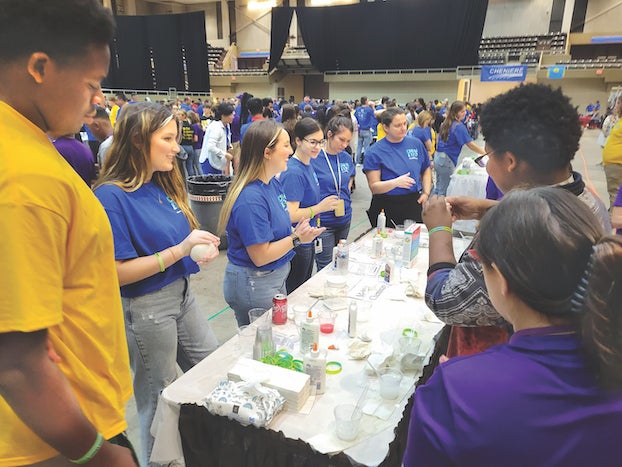2023 Chem Expo: Making learning fun
Published 6:30 am Friday, September 29, 2023

- It may look like a slime ball, but it’s really a polymer, according to McNeese State University students who helped make science fun at the 2023 Expo Thursday at the Lake Charles Civic Center. (Rita LeBleu / American Press)
Lake Area Industry Alliance (LAIA) members and McNeese State University made learning fun for 7th graders at the 2023 Chem Expo.
“Students move through various interactive stations where they participate in experiments using ingredients for products produced by local industries,” explains Jim Rock, executive director of LAIA. “It’s a great way for them to learn more about science and how it’s put into action every day in our
community.”
The Lake Area Industry Alliance is composed of over 20 local industries and it serves as a channel of communication between industries and the community, as well as leaders, public officials, educators and nonprofit organizations. In addition to the Chem Expo, these industries serve public and private school students in Calcasieu and Cameron Parish through programs such as Partners in Education and the Educators’ Institute.
The Chem Expo educates students, faculty and parents about the use of chemistry within local industrial facilities and can spark young minds to think about college and career options.
“We expect 2,083 students,” Rock said. He was there to kick off the first Chem Expo 22 years ago. “Some of the students that attended that first Expo are now working at these local industries.”
First stop for Chem Expo students was an Air Products liquid nitrogen demonstration that produced a steaming cauldron effect as employees quizzed students on celsius and fahrenheit temperatures necessary for freezing water and what happens to molecules as temps get colder. One of the Air Products team said plants use liquid nitrogen to purge tanks. It doesn’t spark or act as an accelerant.
After the Air Product presentation and viewing a model cooling tower as Joe Andrepont at Westlake Corp talked about condensation, evaporation and steam, students were ready for hands-on demonstrations. The power of soap was demonstrated with hydrophobic pepper – it doesn’t like water and stays on the surface of water which is made up of two hydrogen atoms and one oxygen atom. It is a polar molecule, attracted to itself which causes surface tension. Surface tension helps small particles sit on top of the water. Soap, a surfactant, reduces surface tension. A soapy finger sends the pepper flakes flying to the edge of the dish.
While students at the first table learned why soap works and the importance of using it when washing, students at the second table were playing with giant whitish slime blobs.
“We’re making a polymer, a large chain of repeating units which are called monomers, which are linked through chemical bonds,” said Hailey Opal, a McNeese State University.
Adding Elmer’s glue to a water and borax solution causes a chemical reaction which produces a highly flexible, cross-linked polymer, a slime ball.
The arrival of students is staggered at the annual event. Around 9:30 a.m., LeBlanc Middle, W.W. Lewis and Maplewood schools were lining up in their appointed places to see the nitrogen show that one of them called, “Mr. Freeze.” DeQuincy, Vinton and Moss Bluff Middle schools were leaving. Would students retain any of these lessons once they left the Civic Center? Elliott Mitchell and Kaden Cubbage answered in the affirmative. Mitchell not only found out oil and water don’t mix, but why they don’t.
“It has to do with surface tension,” Mitchell said. Water is a polar molecule with a positive charge on one end and a negative charge on the other. That’s why water molecules stick together. The structure of an oil molecule is nonpolar. Cubbage liked the experiment some students will probably replicate at home with their parents’ permission. It might look or sound like a recipe for disaster. If the oranges drop into the glass of water without mishap, it demonstrates Isaac Newton’s First Law of Motion, an object at rest will remain at rest, until force is applied. If the experiment doesn’t go quite as planned, those spilled polar molecules will make for an easy clean up with or without the use of a surfactant.





